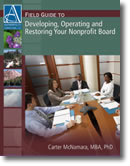Ideas to Generate
Participation in Committees
© Copyright Carter
McNamara, MBA, PhD
Also consider
Related Library Topics
Learn More in the Library’s Blogs Related to Participation in Committees
In addition to the articles on this current page, see the following blogs which
have posts related to Organizational Design. Scan down the blog’s page to see
various posts. Also see the section “Recent Blog Posts” in the sidebar
of the blog or click on “next” near the bottom of a post in the blog.
Library’s Boards
of Directors Blog
Library’s
Nonprofit Capacity Building Blog
To Increase Attendance and/or Participation in Committees
- Ensure committee chairs understand and can convey the role of the committee
to members, and that the chair and members have up-to-date job descriptions. - Ensure adequate orientation that describes the organization and its unique
services, and how the committee contributes to this mission. - Remember that the organization and its committees deserve strong attendance
and participation. Don’t fall prey to the perspective that “we’re lucky
just get anyone.” Set a standard for the best. - Have ground rules that support participation and attendance. Revisit the
ground rules every other meeting and post them on the bottom of agendas. - Let go of “dead wood.” It often help to decrease the number of
committee members rather than increase them. - Consider using subcommittees to increase individual responsibilities and
focus on goals. - Conduct yearly committee evaluations that includes a clear evaluation process
and where each committee member evaluates the other members, and each member
receives a written report about their strengths and how they can improve their
contributions. - Attempt to provide individual assignments to the committee members.
- Have at least one staff member participate in each committee to help with
administrative support and providing information. - Monitor quorum requirements for the entire board (as set forth usually
in ByLaws), or the minimum number of board members who must be present for
the board to officially enact business. This quorum, when not met, will serve
as a clear indicator, or signal, that the board is in trouble. - Develop a committee attendance policy that specifies the number of times
a member can be absent in consecutive meetings and in total meetings per time
period. - Generate minutes for each committee meeting to get closure on items and
help members comprehend the progress made by the committee. - In committee meeting reports, include noting who is present and who is
absent. - Consider having low-attendance members involved in some other form of service
to the organization, e.g., a “friends of the organization,” or something
like that, who attends to special events rather than ongoing activities. - Have a “summit meeting” with committee members to discuss the
low attendance problem, and use a round-table approach so each person must
speak up with their opinions. - Rotate in new members every year.
Return to All About Boards of Directors
For the Category of Boards of Directors:
To round out your knowledge of this Library topic, you may want to review some related topics, available from the link below. Each of the related topics includes free, online resources.
Also, scan the Recommended Books listed below. They have been selected for their relevance and highly practical nature.
 Sections of this topic
Sections of this topic

















